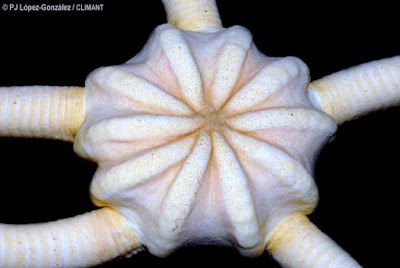One of the most emblematic animals from Antarctic waters is the euryalid Astrotoma agassizii Lyman, 1875. Gigant, long-lived, with a disk diameter of up to 70 mm and an age which could overpass 100 years; Dahm (1996) calculated, by the growth rings of the arm vertebrae, the age of 90 years for a specimen of disc less than 50 mm.
Astrotoma is a predator, who climbs up the gorgonians from Primnoella and Thouarella genus, waits patiently for the arrival of copepods which will be caught by its ambulacral tentacles Dearborn et al (1986). His rough and tough skin defends it from the nematocysts that the polyps of the Gorgon throw without success. Astrotoma grabs the gorgonia with its modified arm spines and the hooklets that cover the skin of its arms arranged in rings.
1. ambulacral pore, 2. arm spine, 3. arm ring with hooklets, 4. jaws, 5. genital slit, 6. radial shields, 7. madreporite
Astrotoma is a hermaphrodite incubator Bernasconi (1965), something common in Antarctic Brittle stars, but the thing that is not so common is that, without a planktonic development that would help to expand its geographical distribution, it however presents a wide circumpolar distribution in shelf waters, in addition to being presented in the waters of Magellan. The Antarctic Circumpolar Current is a divisor of polar and magellanic populations Hunter (2008), there is no gene flow but these are isolated populations, molecularly distinct, although it doesn’t seem to be any morphological differentiation. Smirnov (1986) suggested the possibility of phoresis by macrophytes, an interesting option that could explain their wide distribution.
Arm ring with hooklets
References
Bernasconi I (1965) Astrotoma agassizii Lyman, especie vivipara del Atlántico Sur. Physis 25 (69): 1-5
Dahm C (1996) Ökologie und populationsdynamik antarktischer ophiuroiden (Echinodermata). Ber Polarforsch 194: 1-289
Dearborn, JH, Ferrari FD, Edwards KC (1986) Can pelagic aggregations cause benthic satiation? Feeding biology of the Antarctic brittle star Astrotoma agassizii (Echinodermata: Ophiuroidea). Ant. Res. Ser., 44 (Biology of the Antarctic Seas XVII): 1-28
Hunter RL & Halanych KM (2008) Evaluating Connectivity in the Brooding Brittle Star Astrotoma agassizii across the Drake Passage in the Southern Ocean. J Hered 99:137-148
Smirnov IS (1984) Fauna of antarctic and subantarctic brittle-stars. Ph.D . Leningrad. 1984 [in Russian]
Collected by Pablo J. González-López. Cruiser ANTARKTIS XXIII/8 Polarstern
May 2010




No hay comentarios:
Publicar un comentario
Tus preguntas y comentarios son bien recibidos. Your questions and comments are welcome